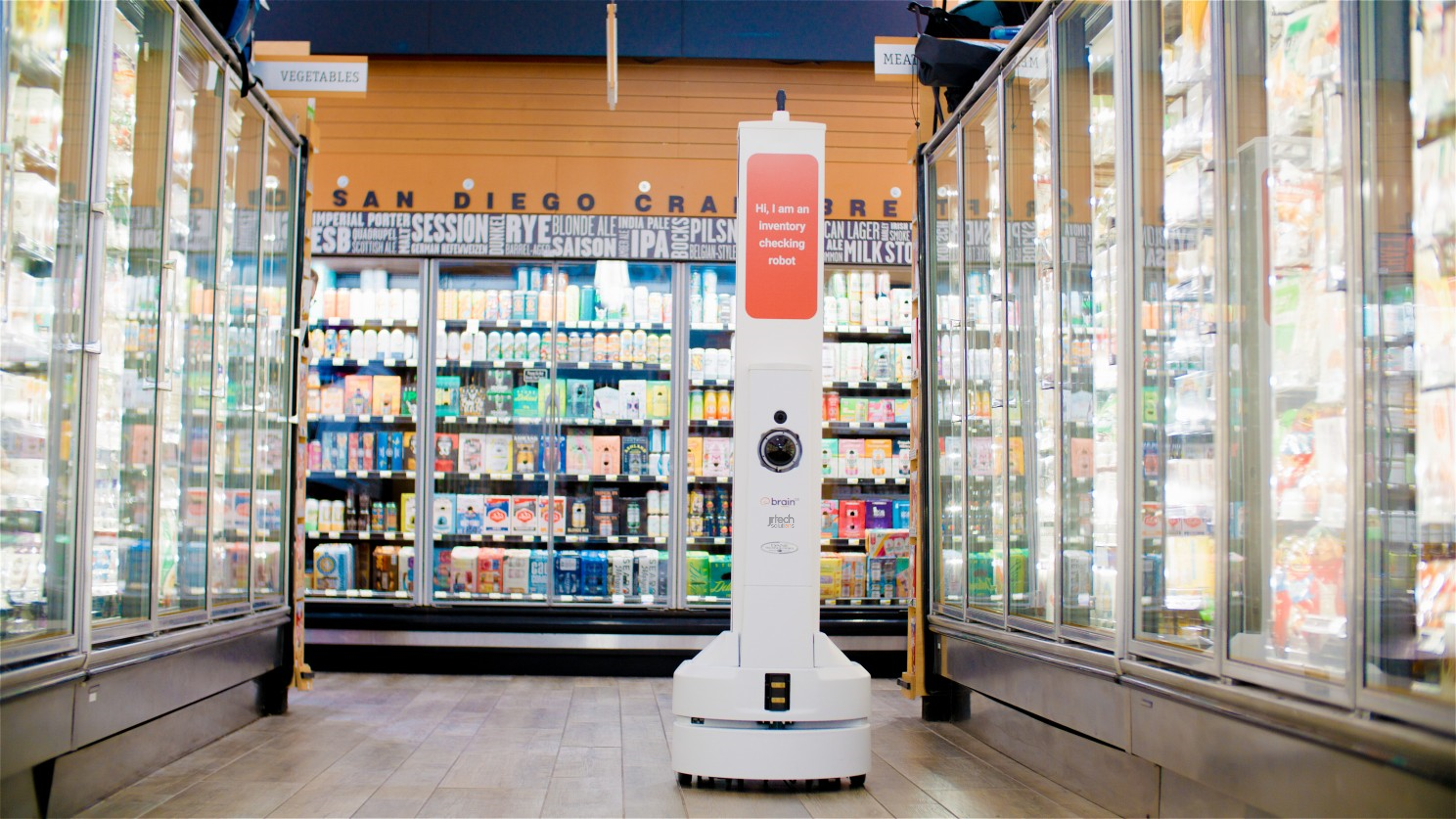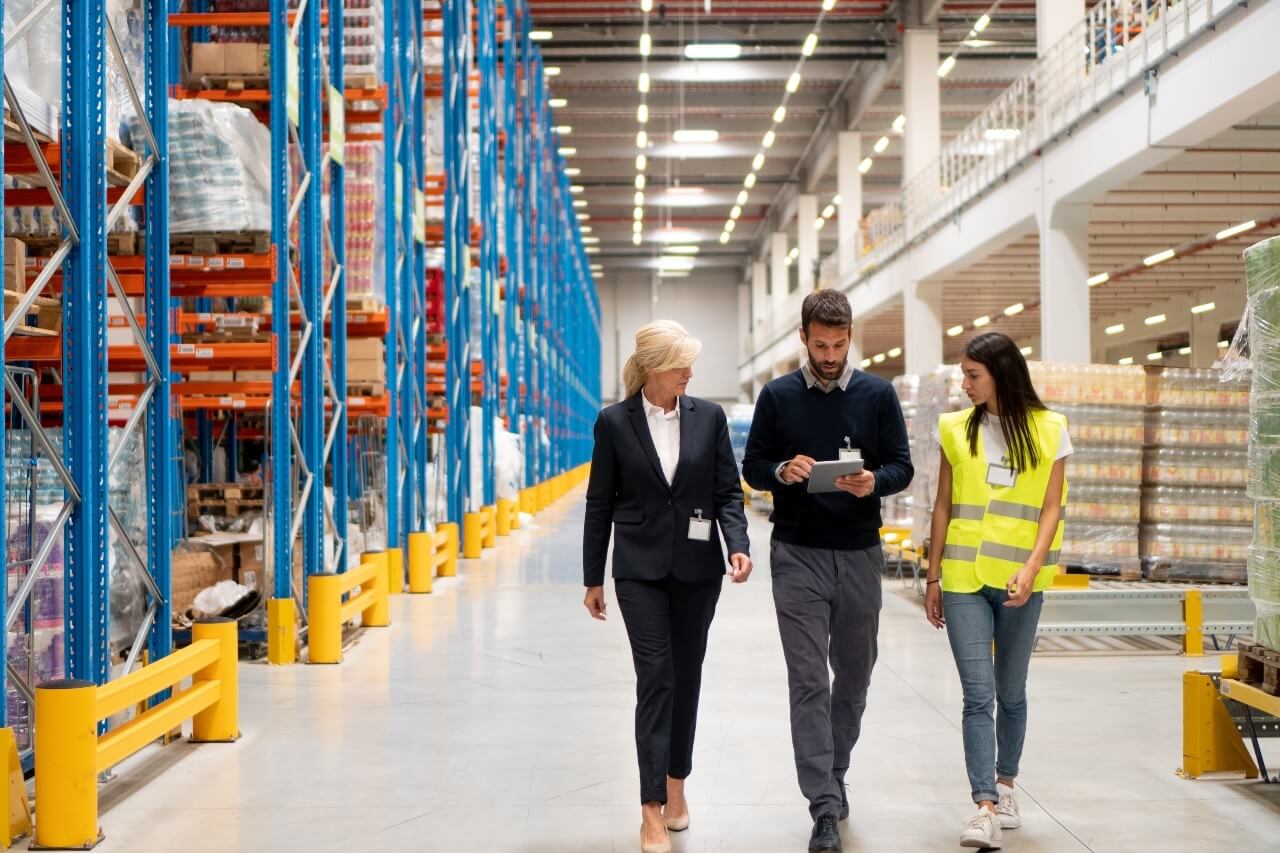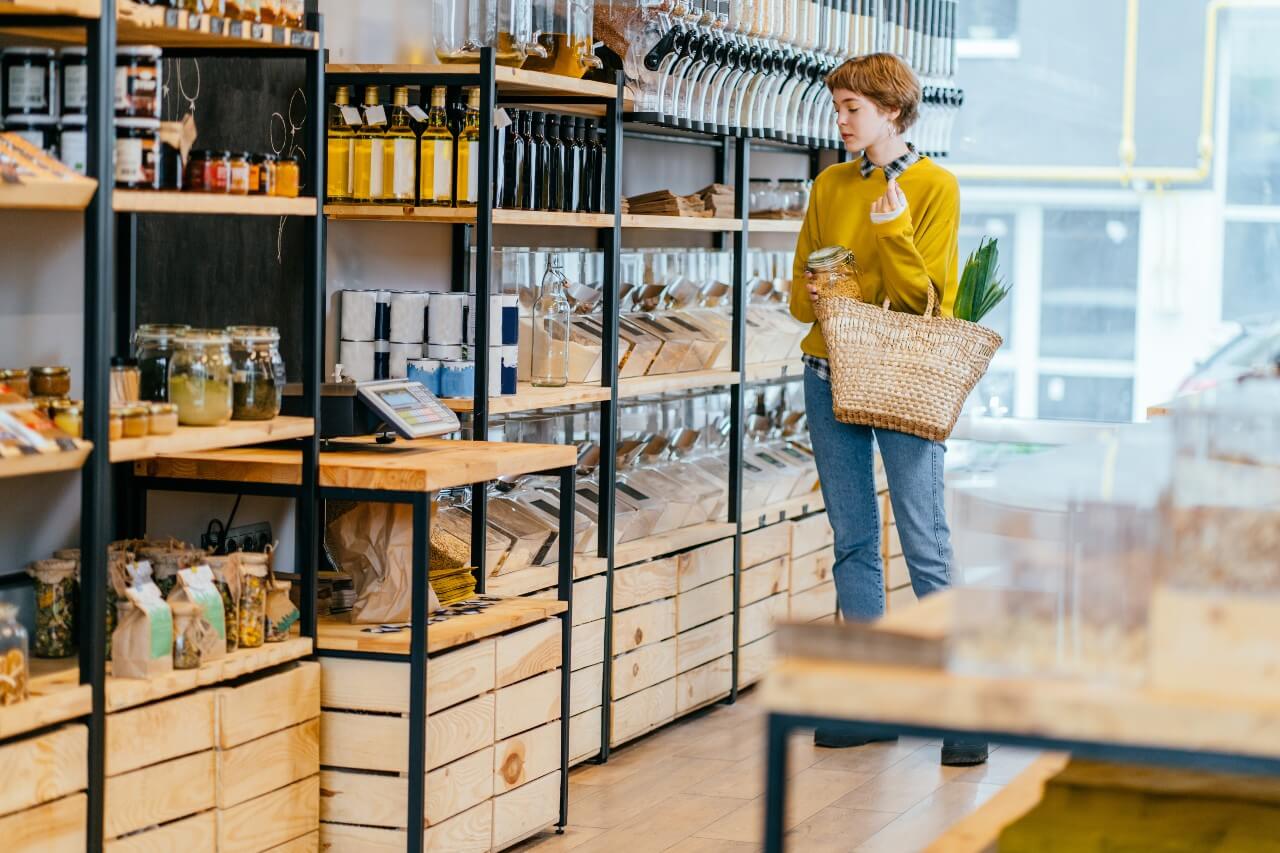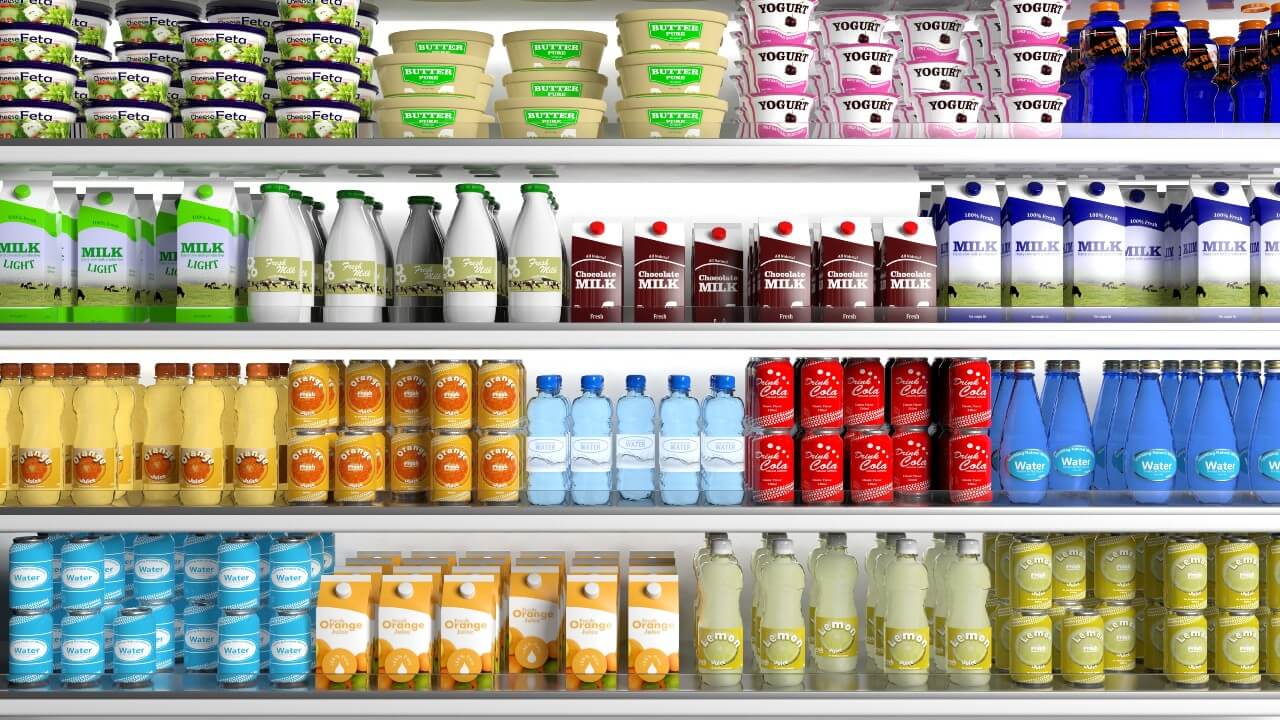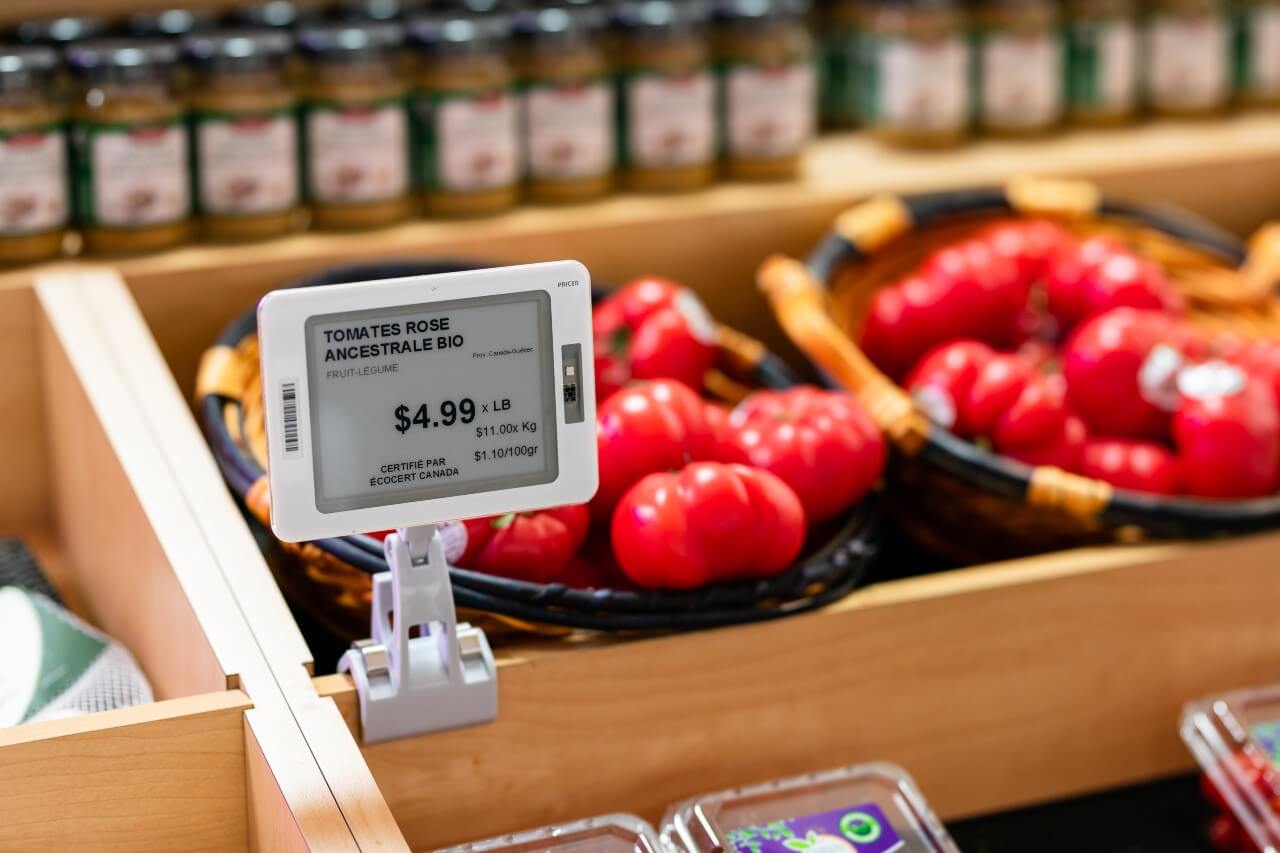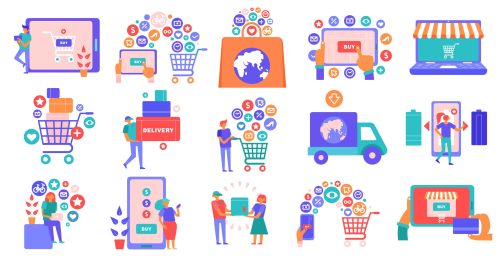MONTREAL and SAN DIEGO, Oct. 22, 2024 /CNW/ – Brain Corp, the autonomous technology company creating transformative solutions in robotics and AI, and JRTech Solutions, the largest provider of Electronic Shelf Labels (ESL) in Canada, today announced an exclusive partnership to bring autonomous inventory management solutions to the Canadian market. Under this agreement, JRTech Solutions will become the exclusive provider in Canada of Brain Corp’s BrainOS® Sense Suite, an end-to-end inventory management platform that helps retailers autonomously manage their in-store inventory with robots and artificial intelligence (AI).
Continue readingWhat is a Dark Store?
A dark store is a converted retail outlet or small warehouse-like distribution center that fulfills orders customers place online. Order fulfillment may involve home delivery, curbside and/or in-store pickup options. Dark stores generally do not provide in-store shopping.
With the meteoric rise in popularity of online shopping, the dark store model is quickly gaining traction among brick-and-mortar retailers. Discover the origins, benefits and requirements of dark stores in this article!
The origins of dark stores
Dark stores are a new retail business model that was born out of necessity during the COVID-19 pandemic. The restrictions left many storefronts closed for months at a time, and consumers were told to stay home and avoid contact with others. Online ordering surged, and brick-and-mortar retailers were left looking for ways to move their inventory and stay competitive in the new reality.
As a result, many brick-and-mortar locations converted, at least temporarily, to fulfillment centers and began to offer delivery and click and collect options that allowed customers to maintain social distance. While the era of lockdowns appears to be behind us, the popularity of online ordering and the resulting consumer expectations are here to stay.
How dark stores work
At dark stores, orders are placed online and employees walk among the shelves picking items to fulfill them. The interior may resemble a conventional store, but the layout is optimized for order picking and the aisles are more densely packed, since they aren’t designed to accommodate in-store shoppers. There’s also no need for promotional displays or digital signage, because customers aren’t there to see them.
Orders are displayed on handheld tablets, and pickers place the necessary items on trolleys, often picking for more than one order at a time. The orders are then packed for in-store or curbside pickup or sent out by van for delivery.
Home delivery
Purpose-built dark stores are often situated on the outskirts of cities near convenient roadways to facilitate delivery, unlike conventional shops, which tend to be centrally located in high-traffic areas to encourage walk-ins. Fleets of vehicles deliver orders on routes optimized for peak efficiency and may even offer same-day delivery.
Curbside pickup
Dark stores usually have designated parking spaces for curbside pickup. Customers can pull up in their vehicle and have their order brought out to them by an employee for a convenient, contactless experience.
In-store pickup
If in-store pickup is available, there will usually be a specially-designated area for it inside the building near the front entrance. This is a great option for customers who aren’t interested in wandering through the aisles to find their items but still want to inspect them or try them on before finalizing their purchase.
The benefits of dark stores
Dark stores have a wide variety of benefits for customers and businesses alike.
Customer convenience
Dark stores improve the customer experience because they offer the convenience of online ordering and several different ways to obtain the items purchased. Shoppers are spared the lengthy process of searching through the aisles and can choose easy, fast delivery straight to their doorstep or pick-up options that can include inspecting the merchandise or contactless collection, whichever they prefer.
Space and organization
Dark stores can be situated in more outlying areas, resulting in lower real estate costs and allowing for larger premises. A dark store may be as much as two to four times larger than a conventional retail store. With extra space and narrower aisles, dark stores have much more room for additional inventory, meaning a greater number of options and fewer stock shortages for customers.
Furthermore, the layout of a dark store can be optimized for picking orders rather than being designed for visual merchandising purposes.
24/7 operation
Some dark stores operate around the clock, picking and packing orders overnight and providing pick-up and delivery services during normal shopping hours. While conventional retail stores are usually subject to laws that restrict their operating hours, dark stores are not bound by the same restrictions and can operate 24/7, 365 days a year.
Efficiency and control
Since their operations are geared towards picking and fulfilling orders that are placed online, dark stores work with modern technology to make the process as efficient as possible. Automation and optimization help them fulfill more orders faster and with less personnel.
Furthermore, the use of technology and the fact that all items are picked by employees give dark store operators much more control over their inventory than conventional retailers.
The technological requirements of dark stores
Technology is the key to success for dark stores. They need software that can automatically assess the online orders placed, organize and optimize the list of items to be picked based on store layout, and send that information to the employees responsible for the task.
Electronic shelf labels are also vital technology for dark store efficiency. They can be used in conjunction with store software and geolocation technology to guide pickers to the correct items more quickly. Flashing label lights alert employees to the location of the next item, shaving off 5 to 10 seconds per pick and boosting pick rates from an average of 25 per hour to up to 150.
Furthermore, electronic shelf labels can display important information to help streamline inventory management—current stock status, next scheduled replenishment, item details, sell-by dates and more can be accessed quickly and easily.
Equip your dark store with electronic shelf labels from JRTech
The dark store model is here to stay, and it can provide many benefits for retailers that know how to make the most of it. Using the right technology is key to maintaining efficient operations, keeping an eye on stock to minimize waste and shortages, and providing customers with a positive experience.
Whether you are a dark store operator or a conventional retailer, you can benefit greatly from the world’s most reliable electronic shelf labels system, offered by JRTech Solutions. Contact us today to streamline your business with our digital pricing technology!
How Much Do Electronic Shelf Labels Cost?
Electronic shelf labels (ESLs) are a digital upgrade for product labelling that has major advantages for retailers. These digital price tags can drastically improve efficiency and accuracy on everything from price updates to restocking, lowering labour costs and enhancing the shopper experience.
Are the many benefits of electronic shelf labels enough to justify the expense of their installation and upkeep? Discover the factors that affect the pricing of electronic shelf labels and determine whether they are a worthwhile investment for your business!
Factors that influence electronic shelf label price
Store size and number of products
The cost of upgrading to electronic shelf labels depends first and foremost on the number of labels you want to buy. The size of your store and the number of products you offer will determine the number of labels you need and consequently, the cost of the upgrade.
Type of shelf label
There are several different types and sizes of electronic shelf labels available, each with its own features and advantages. Note that you can use more than one type of label in your store!
LCD shelf labels
LCD shelf labels are a great option for smaller businesses that are looking to upgrade their signage in a cost-effective way. These price tags bring all of the main benefits of digitalization, such as automatic price updates and flash-guided restocking, but lack some of the additional features of their more sophisticated counterparts. LCD labels come in small and medium sizes.
Graphic shelf labels
Graphic shelf labels, while more expensive but offer a better ROI, come in high-definition display and have a variety of additional features and sizes for more customizable digital signage. Available features include:
- SmartTAG Power+, which provides a bright 4-color display that will increase the visibility of promotions and enhance the customer experience.
- Instant Flash with 7 different colours, which can be assigned to different people from your staff, making it easier for employees working on a single operation such as Click-&-Collect or Shelf Replenishment to locate and process their assigned products.
- A built-in NFC function, which customers can access by tapping their smartphone on the label to get more information and features about the product being sold, enhancing the shopping experience.
Infrared (IR) or Radio-Frequency (RF)
Most electronic shelf labels receive commands via either radio-frequency or infrared technology. While infrared communication is a more expensive option, due to the fact that it is unique on the ESL market and only Pricer electronic labels from JRTech Solutions have the ability to operate on this communication system, it offers many more benefits than a radio-frequency system:
- Infrared communication is bidirectional, meaning that the labels can acknowledge when commands are received.
- Product information is received in seconds, whereas radio-frequency communication takes longer.
- It can be difficult for radio waves to make it through an environment already cluttered with other wireless signals such as WiFi and Bluetooth, whereas infrared will remain unaffected and has zero interference.
- Radio-frequency communication takes much more energy, meaning the label’s battery will deplete faster than its infrared counterparts.
Check out this testimonial from hardware giant Rona attesting to the benefits of switching from radio-frequency to infrared electronic shelf labels!
Are electronic shelf labels a worthwhile investment?
Despite the initial start-up cost, electronic shelf labels are a worthwhile investment in the long run. Having digital price tags eliminates the need for printing and manually changing paper labels for each price update, resulting in considerable savings on labour and materials.
Once purchased, ESLs require very little upkeep. Businesses that implement electronic shelf labels can generally recoup their investment within 8 to 15 months, and a high-quality infrared electronic shelf label has a battery life that can last up to 10 or even 20 years. Avril Supermarché Santé has been using theirs since 2010!
Get an estimate for your store’s electronic price tags
JRTech Solutions is the North American supplier for digital pricing solutions from industry pioneer Pricer. If you’d like to find out more about the cost of our electronic shelf labels, contact us for an estimate! We will be happy to discuss your needs.
What is Visual Merchandising? Techniques & Benefits in Retail Stores
With the rise of e-commerce as a mainstream option, brick-and-mortar stores are having to work harder than ever to remain competitive and retain customer interest. Visual merchandising is one of the strategies that can be used to increase in-store traffic, boost sales and improve customer retention.
It involves optimizing every aspect of the store environment, from signage and product displays to lighting and sound to draw customers in, make them feel comfortable and encourage them to make purchases. It plays a crucial role in enhancing a store’s appeal, atmosphere and customer experience.
The importance and benefits of visual merchandising
The environment a customer is in affects the purchasing decisions they make. Factors such as a poor layout can deter customers from returning because it is confusing and detracts from their enjoyment of the shopping experience. It’s in retailers’ best interests to create an efficient, customer-friendly environment that makes shopping easier for customers and increases the likelihood of repeat business.
In addition to improving the shopping experience, visual merchandising techniques can be used strategically to highlight products with high profit margins, keep customers in the store longer, and affect their mood to encourage impulse buying.
Visual merchandising techniques
Store layout
The layout determines how customers move through the store, where they spend the most time and what they see. An effective layout will encourage shoppers to go through the whole store. For example, grocery stores tend to place basic necessities like milk at the very back so that customers must walk past other items and are more likely to impulse buy. Another example is Ikea’s famously labyrinthine sales floor, which forces shoppers to walk through every single section to get to the exit.
Signage
Having clear signage is a vital aspect of a systematic, organized store environment. Signs help customers find their way, make them feel more at ease and prevent them from getting frustrated or overwhelmed.
Promotional signage can also be used to draw shoppers’ eyes to particular products and highlight their features and benefits.
Technology
As the digital transformation sweeps the retail industry, phygitalization, the integration of digital solutions into the physical shopping space, is becoming increasingly important for stores that want to remain competitive.
Digital signage
There are endless possibilities for digital signage in retail. This type of visual merchandising can be used to highlight special promotions, product demonstrations or vibrant lifestyle images that help create emotional connections with products. Some digital screens even feature interactive options that allow customers to choose their content and encourage them to input their contact information.
Electronic shelf labels
Electronic shelf labels are indispensable tools for retailers in the digital age! With digital labels, retailers can automate price updates, significantly reducing the number of pricing errors and improving customer experience. These digital price tags also include additional features such as alerting employees to low stock levels, which helps with inventory management and ensures that products remain available to customers.
Product arrangement
The way products are arranged has a significant impact on purchasing decisions. Visual merchandising techniques can be used to attract customers’ attention to specific products and encourage them to buy.
Point-of-purchase displays
Point-of-purchase displays are product arrangements and marketing materials that showcase specific items in-store. Displaying small items near the checkout counter can encourage shoppers to impulse buy, for example, and arranging complementary products together can help remind customers about extras they might need and inspire additional purchases.
Window displays
Attractive window displays are one of the main techniques retailers use to entice shoppers to come into their stores. Windows are the place to display your newest and best-selling items. You can even arrange the items to represent a story or theme to add interest. Remember to keep your shop windows spotlessly clean to make a good first impression!
Ambient elements
While often overlooked, ambient elements such as lighting, sounds and smells have a major impact on customers’ moods. It’s advantageous for retailers to optimize the ambiance of their stores and create an atmosphere that reflects their brand identify and sales goals.
Lighting
Choose your lighting carefully based on what you want to achieve. Bright light creates a sense of honesty, positivity, fun, and excitement. It can promote impulse purchasing, but it also makes customers move through the store faster. On the other hand, softer lighting creates a calmer, more peaceful atmosphere and encourages customers to spend more time in the store.
You can also use lighting strategically to put a literal spotlight on products and areas you want to draw attention to.
Sound
While sound isn’t visual, it is still considered an aspect of visual merchandising because of the effect it has on shoppers. Playing upbeat music can have a positive influence on customers’ moods, while slower music can help them relax and encourage them to spend more time in the store.
The most important thing is to select sounds that will appeal to your target audience. For example, a young, hip clothing shop might opt for pop music, while a mountaineering store might choose to dispense with music altogether and play ambient nature sounds.
Smell
Smell is one of the most subconscious yet powerful senses. It can provoke emotions, trigger memories and have strong positive or negative associations. For example, the smell of fresh bread or apple pie makes complete sense in a bakery, but it can also create a delightfully homey feel in furniture and home décor stores. Seasonal scents like evergreen can help create the right atmosphere during the holidays.
Upgrade your visual merchandising for the digital age with JRTech Solutions!
Modern-day consumers are used to the vibrant, fast-paced and information-rich experience that online shopping offers. To compete successfully, brick-and-mortar retailers need to include digital tools in their visual merchandising strategy to help recreate that experience in store.
JRTech Solutions is a leading supplier of electronic shelf labels and digital signage in North America. Not only can our digital pricing solutions contribute to optimizing the in-store environment, but they also drastically reduce labour costs by eliminating the need for employees to manually change every price tag, poster and sign. Contact us today to take your in-store experience to the next level!
The Benefits of Point-of-Purchase Displays for Grocery Stores and Retail
Point-of-purchase (POP) display is a term that covers a variety of marketing tools that are used in stores to advertise products and encourage customers to buy. They include physical displays that showcase products, digital advertisements on screens in-store, and more.
Unlike other types of marketing, point-of-purchase displays are not intended to attract additional foot traffic to a store—rather, the goal is to target customers who are already in the store to increase sales. The benefit of targeting in-store shoppers is that they are highly-engaged prospects—they are already interested in the products you offer and very close to making purchasing decisions. All they need is a nudge in the right direction, and that’s where point-of-purchase displays come in!
Types of point-of-purchase displays
Digital point-of-purchase displays
Digital POP displays generally consist of screens that can be mounted around grocery and retail stores to advertise products. They can show slideshows, videos or animations explaining how and when to use the product, feature lifestyle shots of people enjoying the product to evoke positive emotions in customers, or even offer interactive content that encourages shoppers to provide their contact information.
As the digital transformation sweeps through the retail industry, savvy retailers will use creative digital solutions to keep their customers engaged and loyal. A good phygitalization strategy, the integration of the digital into the physical shopping space, can help prevent customers from straying to online shopping or competitors.
End-cap displays
“End-cap” refers to the shelving on the end of an aisle. Customers don’t always venture down every aisle, but almost all of them will see the ends of the aisles, making these high-traffic areas perfect for point-of-purchase displays!
Displays near the checkout line
Displaying small, inexpensive items near the checkout counter can help drive sales. The customers in line have already decided to make a purchase, and are therefore more likely to pick up a few extra items if they won’t add too much to the total bill.
Checkout displays can turn the nuisance of a long lineup into an extension of the shopping experience that will keep customers engaged and interested while they wait. Retail giants like Walmart and Canadian Tire have optimized this strategy by creating a path of product displays where customers line up.
The many benefits of point-of-purchase displays
Attention-grabbing displays
Many shoppers tend to skim the shelves looking for products. Unfortunately, the packaging is often insufficient to convince them to make a purchase. Point-of-purchase displays provide bigger, bolder, more visually appealing marketing material that customers will be more likely to notice. Visually striking or interactive displays help attract customer attention and make the shopping experience more enjoyable.
An opportunity to highlight product promotions
Point-of-purchase displays are a great way to showcase the promotions you have on offer and encourage shoppers to take advantage of them. Promotions affect a product’s perceived value. If consumers think they’re getting a deal, they might be persuaded to make a purchase they wouldn’t buy otherwise. This is also a great strategy for getting rid of excess inventory!
Enhanced visibility
With the sheer number of products crowding shelves these days, it’s easy for shoppers to get overwhelmed and overlook things. Point-of-purchase displays can boost the visibility of products at key points during the decision-making process to increase sales. This can be done by placing product displays at strategic locations such as end-caps or near the checkout counter lineup, or with bold digital signage that draws eyes to the product.
Versatility
Particularly with temporary and digital point-of-purchase displays, it’s easy to feature different products and change them up regularly so that each time customers come in, they can discover something new. Integrating digital signage in retail and grocery stores brings an incredible amount of flexibility, including dynamic pricing capabilities, where prices can be adjusted as needed based on the competition, available stock, and more!
A way to provide shoppers with additional information
Point-of-purchase displays are a great opportunity to tell shoppers about the qualities of a particular product and provide them with more in-depth information than is available on the packaging. Highlighting a product’s features and benefits gives customers important details that can help them make a purchasing decision. Even something as small as a QR code on an electronic shelf label can help customers get the information they need!
A strategy for targeting impulse buyers
According to a POPAI shopper engagement study, 82% of purchasing decisions are made in-store. Harnessing that and encouraging impulse buying can have an incredible impact on sales. Point-of-purchase displays are extremely effective tools for targeting people who walk into the store not knowing what they want to buy.
An opportunity to leverage cross-selling
Point-of-purchase displays are a great way to showcase complementary products, such as condiments near the hamburger buns or pitchers and ice cube trays near the lemonade. This strategy can remind customers about additional items they need and increase the amount they end up purchasing.
Digital point-of-purchase displays for a better in-store experience
JR Tech Solutions is North America’s leading supplier of digital pricing and ESL solutions. We offer completely customizable screens that can be updated with the click of a button for vibrant digital point-of-purchase displays that are sure to entice your customers. Contact us today to bring your store into the digital age!
Why is JRTech Solutions the #1 supplier of Electronic Shelf Labels in North America?
Here are 5 reasons why JRTech Solutions is, since 2008, the #1 supplier of electronic shelf labels (ESL) in North America.
Continue readingSmart Shelves: What is Smart Shelving?
Like most industries today, the retail sector is grappling with the rise of the digital era, which has brought profound changes to business operations and customer expectations. While it may seem daunting, retailers must dive into the process of digital transformation in order to remain competitive. Fortunately, with new technology come innovative solutions that can truly revolutionize every aspect of business and are well worth the effort put into the transition!
In this article, discover the concept of smart shelving and find out how these digital solutions can help retailers!
What are smart shelves?
Broadly speaking, smart shelving is the implementation of new technology in retail to optimize the shopping experience. There are a variety of devices that can be installed on and around shelves to keep track of inventory, manage prices, collect data and provide insights into customer preferences and shopping patterns.
Types of smart shelf technology and how they work
Shelf sensors
There are a few different types of sensors that can be used on store shelves. Weight sensors can track inventory as products are removed and detect when items are out of stock. This makes it much easier to manage inventory and determine when restocking is needed, improving customer satisfaction by avoiding situations where items are unexpectedly sold out.
Bluetooth and NFC (near-field communication) can be used to detect shopper proximity and the amount of time they spend in front of the shelf, collecting valuable data about their habits and preferences. Furthermore, if desired, this technology can interact with an app on customers’ phones, showing them personalized promotions based on their previous purchases.
Shelf cameras
Shelf cameras have a variety of applications in retail. Cameras can be installed on opposite shelves to monitor the products in real-time, detecting any gaps and notifying staff accordingly. They can even verify planogram compliance, making sure that every product is in its proper place on the shelves.
Our AI-enabled technology tool, Pricer’s Shelf Vision, is specifically designed and tailored for retail businesses. The Shelf Vision, which on the surface looks like an electronic shelf label (ESL), is actually composed of a sophisticated wide-angle camera that uses a wireless optical system and IoT capabilities.
Meanwhile, front-facing cameras on smart shelves can assess shoppers’ gender and age ranges, facial expressions and moods, providing retailers and manufacturers with important data about customer demographics and how they respond to products, advertising, etc.
Digital signage
Digital signage is the smart alternative to paper posters. Much easier to change and update than their traditional counterparts, digital signs can be used to showcase high-profit-margin products and limited-time deals. They can feature ads, product demonstrations and video testimonials, and even offer interactive options for customers!
Smart signs immediately grab customers’ attention and influence their behaviour and decision-making, all while providing them with a more enjoyable shopping experience.
Electronic shelf labels
Electronic shelf labels (ESLs) are smart replacements for the paper labels that traditionally display the prices of products. They are all connected to a central system and can be updated automatically, removing the need for manual price changes.
Many electronic shelf labels on the market are equipped with flashing lights, but only Pricer digital price tags from JRTech Solutions can guide staff to the correct location when restocking products or picking for click and collect orders. These features can significantly reduce the need for staff and the associated costs at a time when labour is at a premium.
Benefit from smart shelf technology with JRTech Solutions
JRTech is the leading supplier of electronic shelf labels and smart shelving solutions in North America. We are proud to provide retailers with proven technology from industry pioneer Pricer to help them digitalize and meet the needs of the modern world of phygitalization! Contact us today.
Benefits of Electronic Shelf Labels (ESLs) for Pricing Management
As competition continues to intensify in retail, the emergence of new technologies has led point-of-sale and network managers to explore innovative ways to improve sales, enhance customer experience, and optimize employee and inventory management. One significant development is the introduction of electronic shelf labelling (ESL) solutions, which offer new opportunities for effective growth and customer satisfaction strategies.
ESL systems allow for dynamic price adjustments based on market shifts, competition, seasonality, and other factors. They also facilitate the integration of phygital retail experiences, enabling retailers to incorporate that all-important multichannel shopping experience into their strategies. Digital sales continue to play a key role in retail success, and are expected to account for 20.1% of all global retail sales in 2024 for a total of over $6 trillion.
Today’s retail businesses are focused on creating competitive pricing strategies, reducing costs, and increasing sales effectiveness, all of which can be done with greater ease and flexibility using Electronic Shelf Labels.
What are electronic shelf labels?
Electronic shelf labels, also known as digital price tags, are wireless display labels that are used in retail stores. They are a digital replacement for traditional paper labels that have the advantage of being connected to the store’s main systems, facilitating a great many operations in an environment of phygital retail (the concept of combining physical presence with digital features in retail).
8 Benefits of electronic shelf labels
1. Dynamic and accurate pricing
Before the advent of ESLs, it took retail store staff considerable time to manually update labels every time there was a price change or promotion. This process cost companies dearly, both in terms of labour and in terms of frequently inconsistent or inaccurate prices, in particular when events involved multiple store locations and channels.
Now, companies that use ESLs are able to automate prices and update thousands of labels in a matter of minutes. In addition to drastically reducing lag and errors, stores with electronic shelf labels can take advantage of dynamic pricing —the ability to adjust prices at will based on demand, online competition, inventory and shelf life — and create or pause promotions easily.
2. Better omnichannel experience
As technology advances and online shopping becomes more and more prevalent, customers are starting to expect a similar level of accuracy and access to information when shopping at brick-and-mortar stores. Electronic shelf labels seek to narrow the gap between online and offline shopping by providing NFC and QR codes so that customers can access more product information on their mobile phones. They can also be used to collect data and offer personalized promotions to consumers in-store. As personalized communications and choices continue to shape the future of retail across all channels, ESLs are a vital tool for tracking customer preferences and purchasing behavior.
3. Reduced costs and higher ROI
Digital price tags enable companies to save on both labour and materials. Paper labels involve more expenses than you might think: paper, ink, printers and time, and new labels must be printed every time a change is made. Many stores need to change thousands of prices every week, resulting in an inordinate amount of time spent manually changing each label. This also results in a staggering number of pricing errors.
With ESLs, label price changes that once took staff days or even weeks to complete can now be done in minutes, freeing up associates to work on activities with a higher added value, such as replenishing stock and helping shoppers.
More efficient order picking
Since the pandemic, consumers have become accustomed to new ways to shop. For example, click and collect ordering continues to soar in popularity , and while this can be a new source of revenue for retailers, it also adds a new cost to operations, as pickers need time to go through stores collecting orders.
That’s why Pricer ESL systems from JRTech Solutions include geolocation to help staff locate products and optimize their route through the store. Furthermore, electronic shelf labels are equipped with LED lights that will flash to guide pickers to the correct product. These tools can save up to 10 seconds per pick, which adds up very quickly, as well as improving workflow and job satisfaction.
4. Improved inventory management
The same instantly flashing lights that guide order pickers to products can also help staff restock more efficiently. They can simply scan a product with their PDA (personal digital assistant), and the corresponding label will flash to show them where it goes.
Pricer electronic shelf labels from JRTech Solutions can also help with inventory management, both in-store and in warehouses,by alerting staff to out-of-stock products and providing easy access to information such as the amount of stock that should be in the store, past and planned delivery dates and quantities, products that are approaching expiration, etc. Preventing stock-outs is an important element of retail management that can have a major impact on customer retention, and ESLs can help predict and prepare for sudden and unexpected changes in stock levels and purchasing trends.
5. Enhanced promotions
Electronic shelf labels make promotion management far easier, because prices can be updated automatically as many times as desired. Pricer digital labels are available in four of the most commonly used colours to help promotions stand out to consumers.
No matter what type of retail promotion you are implementing, ESLs are the fastest, most efficient and effective way to update and change prices across multiple store locations.
6. An environmentally friendly pricing system
Electronic labels offer significant environmental benefits over traditional paper labels. The production, distribution, and disposal of paper labels have considerable ecological costs, including deforestation, water and energy consumption, and pollution. Even recycled paper requires resources to process, and not all paper gets recycled.
Electronic labels eliminate the need for paper, reducing consumption and waste, thereby lowering your corporate carbon footprint. This digital solution supports retailers’ sustainability efforts and environmentally responsible practices. Additionally, as customers increasingly value sustainability, adopting electronic labels can enhance a retailer’s reputation and customer appeal.
7. Better customer experience and improved customer satisfaction
Consumer retention and engagement are crucial indicators of customer satisfaction. Improving the in-store customer experience is essential for POS managers, and electronic price displays play a significant role. They provide customers with quick access to product information, pricing, and origin, and help identify promotional items through color coding.
Real-time, accurate pricing information enhances transparency and trust, significantly improving customer satisfaction. Since ESLs dramatically increase the accuracy of in-store pricing displays and can even be adjusted to incorporate real-time personalization strategies, they play a key role in the future of customer experience.
8. Compatibility with IoT solutions and AI
As retailers rely more and more heavily on data to influence decisions about pricing and personalization, AI has emerged as an indispensable tool. Artificial intelligence solutions rely on fast, automated data collection and display systems, such as ESLs.
For example, electronic shelf labels can be equipped with AI-driven dynamic pricing systems that automatically create discounts for products with impending expiration dates. The ESLs can display the discounted price and relevant expiration date in addition to the regular price. The AI will then learn from customer behaviour and adjust the discounts accordingly, maximizing profits and minimizing waste.
By incorporating seamless, automated functions into the retail environment, IoT offers retailers the chance to enhance customer experience and boost profits through improved operational efficiency and store management. IoT retail solutions include real-time inventory tracking, data collection for preventive maintenance, warehouse inventory management and other functions that depend on ESLs for full and effective implementation.
Electronic Shelf Labels FAQs
How do ESLs work?
ESLs receive information from a central database or pricing system via infrared light or radio frequencies. This allows prices and product details to be updated instantly across all labels in one or more connected store locations.
What are the biggest advantages of using ESLs?
Electronic Shelf Labels are becoming the accepted standard in retail pricing management. With ESLs, your business can:
- Update prices automatically and instantly, saving labor costs
- Reduce pricing errors compared to manual paper labels
- Implement dynamic/flexible pricing strategies based on demand
- Display more product info beyond just price (e.g. promotions, stock levels)
- Make your operations more environmentally friendly by eliminating paper label waste
How are ESLs powered?
ESLs consist of small digital devices with e-paper or liquid-crystal displays that operate on battery power. Their low power consumption means that their battery life can last 10 years or more!
Can ESLs be used in refrigerated areas?
Yes, many ESL models are designed to be waterproof and function in refrigerated environments like coolers and freezers.
How secure is the wireless communication to ESLs?
ESL systems use proprietary wireless protocols and encryption to ensure the pricing data is transmitted securely.
Who can manage ESL updates?
Managers can assign user accounts to employees of their choice, thereby effectively controlling who is responsible for updating labels.
What is the cost of an ESL system?
The Return on Investment for an electronic labelling system is typically 12 to 18 months. Electronic shelf label costs will vary based on the specific needs of each retailer and may be influenced by factors such as:
- The number of labels
- The type of label
- The chosen connectivity
- The type of installation
- Integration with a cash management system
- Any specific requirements of the user
Take your store to the next level with JRTech ESL systems
There’s no question that electronic price tags can make all the difference for retailers. With automated price changes, improved team efficiency and access to the information consumers want fast, ESLs can truly bring stores into the modern age and help them remain competitive.
JRTech Solutions is North America’s leading supplier of electronic shelf labels. With over 10 years of experience in digital retail pricing and management and proven technology from industry pioneer Pricer, we are well-equipped to help stores optimize their operational efficiency and keep customers engaged and informed! Contact us today.
Technologies to focus on for developing a smart store
The pandemic has accelerated the process of digitalization of the retail industry, giving birth to smart stores, also called “smart retail”…
Continue readingHow are digital technologies a critical aid to retailers in times of inflation?
According to several reports, annual inflation is at its highest level in almost 40 years, particularly since 1991 in Canada, with estimates showing product cost increases of up to 15% by the end of the year. This unprecedented price increase is…
Continue reading
